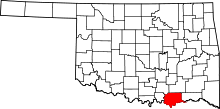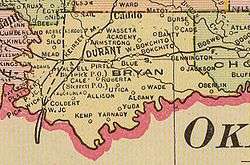Bryan County, Oklahoma
| Bryan County, Oklahoma | |
|---|---|
|
Bryan County Courthouse | |
 Location in the U.S. state of Oklahoma | |
 Oklahoma's location in the U.S. | |
| Founded | 1907 |
| Seat | Durant |
| Largest city | Durant |
| Area | |
| • Total | 944 sq mi (2,445 km2) |
| • Land | 904 sq mi (2,341 km2) |
| • Water | 39 sq mi (101 km2), 4.2% |
| Population (est.) | |
| • (2015) | 44,884 |
| • Density | 49.7/sq mi (19/km²) |
| Congressional district | 2nd |
| Time zone | Central: UTC-6/-5 |
Bryan County is a county located in the U.S. state of Oklahoma. As of the 2010 census, the population was 42,416.[1] Its county seat is Durant.[2] It is the only county in the United States named for Populist politician William Jennings Bryan.
Bryan County comprises the Durant, OK Micropolitan Statistical Area, which is included in the Dallas-Fort Worth and the Texoma region, TX-OK Combined Statistical Area. It is home to the headquarters of the Choctaw Nation of Oklahoma located in Durant.
Bryan County consists of 10 Townships: Albany, Bennington, Bokchito, Brown, Caddo, Calera, Colbert, Kemp, Matoy, and Speairs Townships.[3]
History

The area now known as Bryan County was occupied by the Choctaw Tribe in 1831-2, and became part of Choctaw Nation's Blue County. In 1845, the tribe opened Armstrong Academy for boys near the community of Bokchito. The academy served as Chahta Tamaha, the Choctaw capital, during the Civil War. Bloomfield Academy, a school for Chickasaw girls opened in 1852, just south of the present town of Achille.[4]
The Chickasaw tribe bought part of the Choctaw allocation prior to the Chickasaw migration to Indian Territory. The western quarter of today's Bryan County thus became part of the Chickasaw District in 1837. When the two tribes formally separated into two distinct nations in 1855, the Chickasaw District became the Chickasaw Nation.[4]
The Butterfield Overland Mail and Stage route followed the older Texas Road across the present county during the late 1850s. General Albert Pike established Fort McCulloch for the Confederate Army near the present town of Kenefic on the Blue River. Although no Civil War battles occurred in the vicinity, the fort was garrisoned by more than a thousand Indian troops allied with the Confederates.[4]
Several new towns were created after the Missouri, Kansas and Texas Railway (Katy) built a north-south line through this area in 1872. One such town was Colbert, which became the seat of Blue County and the largest town in the Choctaw Nation. The St. Louis, San Francisco and New Orleans Railroad, later bought by the St. Louis and San Francisco Railway (Frisco), built an east-west line in 1903.[4]
Just prior to statehood, when all tribal governments were dissolved, Blue County was extinguished. Bryan County was officially established on November 16, 1907, and Durant became the county seat.[4]
The Bridge War, also called the Red River Bridge War or the Toll Bridge War, was a 1931 bloodless boundary conflict between the U.S. states of Oklahoma and Texas over an existing toll bridge and a new free bridge crossing the Red River between Grayson County, Texas and Bryan County, Oklahoma.
Geography

According to the U.S. Census Bureau, the county has a total area of 944 square miles (2,440 km2), of which 904 square miles (2,340 km2) is land and 39 square miles (100 km2) (4.2%) is water.[5] The county is in the Coastal Plains physiographic region, and is mostly drained by the Blue River. The Washita River originally drained much of the western part of the county, but now empties into Lake Texoma, which forms much of the southern boundary of the county.[4] The county is a major part of the Texoma region.
Major highways
Adjacent counties
- Atoka County (north)
- Choctaw County (east)
- Lamar County, Texas (southeast)
- Fannin County, Texas (south)
- Grayson County, Texas (southwest)
- Marshall County (west)
- Johnston County (northwest)
Demographics
| Historical population | |||
|---|---|---|---|
| Census | Pop. | %± | |
| 1910 | 29,854 | — | |
| 1920 | 40,700 | 36.3% | |
| 1930 | 32,277 | −20.7% | |
| 1940 | 38,138 | 18.2% | |
| 1950 | 28,999 | −24.0% | |
| 1960 | 24,252 | −16.4% | |
| 1970 | 25,552 | 5.4% | |
| 1980 | 30,535 | 19.5% | |
| 1990 | 32,089 | 5.1% | |
| 2000 | 36,534 | 13.9% | |
| 2010 | 42,416 | 16.1% | |
| Est. 2016 | 45,573 | [6] | 7.4% |
| U.S. Decennial Census[7] 1790-1960[8] 1900-1990[9] 1990-2000[10] 2010-2013[1] | |||

As of the census[11] of 2000, there were 36,534 people, 14,422 households, and 9,936 families residing in the county. The population density was 40 people per square mile (16/km²). There were 16,715 housing units at an average density of 18 per square mile (7/km²). The racial makeup of the county was 80.02% White, 1.42% Black or African American, 12.16% Native American, 0.44% Asian, 0.04% Pacific Islander, 1.08% from other races, and 4.84% from two or more races. 2.65% of the population were Hispanic or Latino of any race. 28.4% were of American, 10.1% Irish, 8.1% German and 6.7% English ancestry according to Census 2000.
There were 14,422 households out of which 30.40% had children under the age of 18 living with them, 54.00% were married couples living together, 10.80% had a female householder with no husband present, and 31.10% were non-families. 26.60% of all households were made up of individuals and 11.50% had someone living alone who was 65 years of age or older. The average household size was 2.47 and the average family size was 2.98.
In the county, the population was spread out with 24.80% under the age of 18, 11.70% from 18 to 24, 25.70% from 25 to 44, 22.30% from 45 to 64, and 15.40% who were 65 years of age or older. The median age was 36 years. For every 100 females there were 95.10 males. For every 100 females age 18 and over, there were 92.40 males.
The median income for a household in the county was $27,888, and the median income for a family was $33,984. Males had a median income of $26,831 versus $20,087 for females. The per capita income for the county was $14,217. About 14.00% of families and 18.40% of the population were below the poverty line, including 21.40% of those under age 18 and 17.00% of those age 65 or over.
Politics
| Voter Registration and Party Enrollment as of January 15, 2017[12] | |||||
|---|---|---|---|---|---|
| Party | Number of Voters | Percentage | |||
| Democratic | 12,837 | 50.71% | |||
| Republican | 8,506 | 33.60% | |||
| Unaffiliated | 3,971 | 15.69% | |||
| Total | 25,314 | 100% | |||
| Year | Republican | Democratic | Third Parties |
|---|---|---|---|
| 2016 | 75.8% 10,478 | 20.3% 2,804 | 3.9% 536 |
| 2012 | 72.1% 9,520 | 27.9% 3,681 | |
| 2008 | 67.8% 9,307 | 32.2% 4,426 | |
| 2004 | 60.0% 8,615 | 40.0% 5,745 | |
| 2000 | 51.8% 6,084 | 47.3% 5,554 | 0.9% 108 |
| 1996 | 34.8% 3,943 | 52.6% 5,962 | 12.6% 1,430 |
| 1992 | 25.6% 3,452 | 46.5% 6,259 | 27.9% 3,757 |
| 1988 | 40.1% 4,615 | 59.6% 6,849 | 0.3% 37 |
| 1984 | 53.1% 6,246 | 46.5% 5,475 | 0.4% 48 |
| 1980 | 37.6% 3,980 | 60.6% 6,410 | 1.8% 192 |
| 1976 | 27.7% 2,848 | 72.0% 7,410 | 0.3% 35 |
| 1972 | 61.9% 5,397 | 36.1% 3,144 | 2.0% 177 |
| 1968 | 33.2% 2,727 | 39.2% 3,214 | 27.6% 2,264 |
| 1964 | 30.9% 2,652 | 69.1% 5,934 | |
| 1960 | 46.5% 3,845 | 53.5% 4,428 | |
| 1956 | 33.9% 2,939 | 66.1% 5,729 | |
| 1952 | 33.1% 3,340 | 66.9% 6,739 | |
| 1948 | 15.0% 1,366 | 85.0% 7,748 | |
| 1944 | 18.9% 1,677 | 80.9% 7,180 | 0.2% 17 |
| 1940 | 19.4% 2,190 | 80.4% 9,095 | 0.2% 25 |
| 1936 | 14.4% 1,362 | 85.4% 8,106 | 0.2% 20 |
| 1932 | 9.7% 825 | 90.3% 7,681 | |
| 1928 | 43.4% 3,014 | 55.9% 3,885 | 0.7% 51 |
| 1924 | 25.2% 1,780 | 65.0% 4,593 | 9.9% 699 |
| 1920 | 38.8% 3,127 | 55.9% 4,502 | 5.3% 424 |
| 1916 | 25.3% 1,267 | 59.4% 2,974 | 15.3% 766 |
| 1912 | 18.5% 711 | 59.3% 2,278 | 22.3% 856 |
Economy
Agriculture, tourism, manufacturing, and distribution are bedrocks of the county's economy. Tourism attractions include Lake Texoma, Lake Durant, the Choctaw Casino Resort, Choctaw Casino Bingo and Fort Washita.
Major employers in the region include the Choctaw Nation of Oklahoma, the headquarters of the J.C. Potter meat processing facility, Durant's Historic Central Business District and Retail District, a Cardinal Glass Industries manufacturing facility, a Big Lots distribution center, the headquarters of First United Bank and First Texoma National Bank, Indian Nation Wholesale, and Wal-Mart.
Communities
City
- Durant (county seat)
Towns
Census-designated places
Other unincorporated communities
NRHP sites
The following sites in Bryan county are on the National Register of Historic Places.
|
|
References
- 1 2 "State & County QuickFacts". United States Census Bureau. Retrieved November 8, 2013.
- ↑ "Find a County". National Association of Counties. Archived from the original on 2011-05-31. Retrieved 2011-06-07.
- ↑ Oklahoma Townships
- 1 2 3 4 5 6 Milligan, James C. "Bryan County," Encyclopedia of Oklahoma History and Culture, 2009. Accessed March 28, 2015.
- ↑ "2010 Census Gazetteer Files". United States Census Bureau. August 22, 2012. Retrieved February 18, 2015.
- ↑ "Population and Housing Unit Estimates". Retrieved June 9, 2017.
- ↑ "U.S. Decennial Census". United States Census Bureau. Archived from the original on May 12, 2015. Retrieved February 18, 2015.
- ↑ "Historical Census Browser". University of Virginia Library. Retrieved February 18, 2015.
- ↑ Forstall, Richard L., ed. (March 27, 1995). "Population of Counties by Decennial Census: 1900 to 1990". United States Census Bureau. Retrieved February 18, 2015.
- ↑ "Census 2000 PHC-T-4. Ranking Tables for Counties: 1990 and 2000" (PDF). United States Census Bureau. April 2, 2001. Retrieved February 18, 2015.
- ↑ "American FactFinder". United States Census Bureau. Archived from the original on 2013-09-11. Retrieved 2008-01-31.
- ↑ https://www.ok.gov/elections/documents/20170115%20-%20Registration%20By%20County%20%28vr2420%29.pdf
- ↑ http://uselectionatlas.org/RESULTS
Further reading
- Bryan County Heritage Association. The History of Bryan County Oklahoma. National ShareGraphics, 1983. 596.
External links
- Encyclopedia of Oklahoma History and Culture - Bryan County
- Oklahoma Digital Maps: Digital Collections of Oklahoma and Indian Territory
| Adjacent places of Bryan County, Oklahoma | ||||
|---|---|---|---|---|
 |
Johnston County | Atoka County |  | |
| Marshall County | |
Choctaw County | ||
| ||||
| | ||||
| Grayson County, Texas | Fannin County, Texas | Lamar County, Texas | ||
Coordinates: 33°58′N 96°15′W / 33.97°N 96.25°W